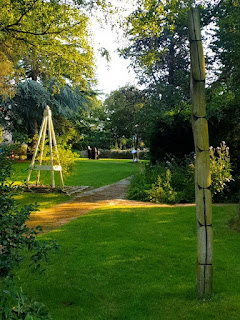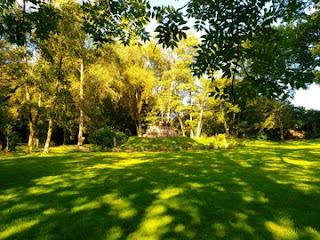On the way to Saffron Walden and the Fry Art Gallery, I called in to Thaxted Parish Church to see their painting by Stanley Clifford-Smith, the most mystical of the Great Bardfield artists.
Clifford-Smith was an active member of the Great Bardfield Artists community during the mid to late 1950s and became the Honorary Secretary of the group. Clifford-Smith and the other Bardfield artists exhibited in the large 'open house' shows in the rural village in 1954, 1955 and 1958 as well as several one-off exhibitions and touring shows in the late 1950s. These exhibitions attracted thousands of visitors and made the art community famous thanks to press, radio and TV coverage.
Clifford-Smith's work in the 1950s was diverse and included Irish and Italian landscapes, images of ships, as well as hypnotic 'mother and child' portraits. He received many positive press reviews for his work while at Great Bardfield. In 1958 he moved to the Old Bakehouse in Great Bardfield with his family., and during the late 1950s he began to teach art in Cambridge. In the early 1960s the Great Bardfield art community fragmented and Clifford-Smith and his family (which now included four sons) moved to Little Baddow Hall near Chelmsford. During his time at Little Baddow he painted mainly thickly textured monochrome moon portraits, works inspired by the 1960s interest in space.
Following his death, several exhibitions were organised; a retrospective at the Minories, Colchester (1969), Little Baddow Hall Arts Centre (1979) and at the Fry Art Gallery, Saffron Walden (1998). His work is included in several collections including the University of Cambridge, Benjamin Britten Foundation, Aldeburgh, Suffolk; the Beecroft Art Gallery, Southend, Essex; and Thaxted Church, Essex.
The Fry Public Art Gallery was opened in 1987 and houses an impressive number of paintings, prints, illustrations, wallpapers and decorative designs by artists of the 20th century and the present day who have local connections and have made a significant contribution to their field. There is an emphasis on those who for a variety of reasons settled in Great Bardfield between the early thirties of the last century and the death in 1983 of John Aldridge RA who had lived in the village for fifty years.
Apart from the Great Bardfield Artists, after the end of World War II, north west Essex became the home for a later group of younger, more radical artists, embracing neo-romantic ideals. These were Michael Ayrton, Robert Colquhoun, Robert MacBryde, and Keith Vaughan. The Fry Art Gallery has good holdings of these artists and are delighted that the Ingram Collection has lent further works by Ayrton and Vaughan as well as Graham Sutherland, John Craxton and John Minton for the exhibition 'A World of Private Mystery: British Neo-Romantics'.An additional exhibition 'Art and Design' draws from the Gallery's Permanent Collection works which emphasise the contribution which the artists made to British design.
---------------------------------------------------------------------------------------------------------









































No comments:
Post a Comment